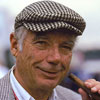JULY 10, 2008
Bernard Cahier 1927-2008
Bernard Cahier, one of the leading photojournalists in the history of Formula 1 has died at the age of 81. Cahier began photographing F1 in 1952 and developed strong friendships ith many of the stars of the era, notably Juan Manuel Fangio, Stirling Moss, Graham Hill, Jim Clark, Phil Hill, Dan Gurney, Jackie Stewart and Emerson Fittipaldi. In 1968 he was one of the founders of the International Racing Press Association (IRPA) which began the process of organising the media in F1, the famous red IRP armband becoming the F1 press pass for many years.

© The Cahier Archive
Bernard Cahier, who has died at the age of 81, was the prototype Formula 1 photo-journalist. Beginning his career in Grand Prix racing in 1952 he was a leading figure in F1 right through until the early 1980s. His photographs, and those of his son Paul-Henri, have charted virtually the entire history of the sport and his work as president of the International Racing Press Association (IRPA) laid the foundations for the modern system of F1 media passes. In the 1960s and 1970s a red IRPA armband was the ultimate ticket for any journalist in the sport. Eventually this put Cahier into conflict with the FIA and FOCA, a battle which he could not win, but he remained close to the sport, running the Cahier Archive, one of the sport's most complete archives.
Born in Marseilles in 1927, the son of a soldier (who ultimately became a general) Bernard caught the motor racing bug early in life, after attending the Marseilles GP at Miramas in 1932. He was 12 when World War II broke out and at the age of 17 he joined the resistance in Brittany, being active before the Normandy landings, unlike many who would claim resistance affiliations.
After the region was liberated in the summer of 1944 he joined General Philippe Leclerc's 2nd Armored Division and worked as an engineer, clearing mines and was involved in the clearing of the Royan Pocket in western France and the liberation of southern Germany in the spring of 1945. He was then sent off to the French colony of Cameroon for a year, before heading to the United States to study at UCLA. While there he met and married Joan Updike. He also became involved in the southern California sports car scene and worked at Roger Barlow's International Motors, which was the largest foreign car dealership in Los Angeles at the time, selling European sports cars to the Americans. One of his fellow salesman was a youngster called Phil Hill and the chief mechanic was Ritchie Ginther. Barlow did some racing and Cahier also became involved at the wheel of a MG before deciding to write about the sport. In 1952 the Cahiers moved to Paris and Bernard set off to Monza to photograph the Italian Grand Prix. On the strength of that trip the publisher LV Roussel gave him the job of writing about F1 for L'Action Automobile. He quickly became one of the inner circle in F1 getting to know all the drivers, team managers and sponsors in the sport. In time he became a celebrity in his own right, the public warming to his anecdotes and photographs that had the personal feel of holiday snaps. He played an important role in linking up the American racing scene with Formula 1 and helped to get Phil Hill and Dan Gurney into their drives in Europe. He then became the public relations consultant of Goodyear in F1 and was celebrated not only for his connections inside the business but also for his charm and hospitality. He knew everyone and brokered many deals. When there was time he raced himself, winning the GT class on the Targa Florio in 1967. He provided the very first F1 motorhome - a caravan - for the use of the media. In the 1950s and 1960s he developed strng friendships with many of the great names of the sport, notably Juan Manuel Fangio and Stirling Moss. When Hollywood came to F1 in 1966 Cahier helped John Frankenheimer to make the movie happen and ended up playing a role himself. In 1968 he bcame one of the founder members of the IRPA and in later years became its chief advocate and the representative of the media in F1 circles. This led to inevitable tension with Jean-Marie Balestre and Bernie Ecclestone, but Cahier fought well and when denied a pass for the French GP fought back by using his connections to get around the system. The fact that his sister was married to Robert Mitterand, brother of President Francois Mitterand, was obviously useful. He continued to play a role in F1 until 1983 when a change in management at Goodyear resulted in the termination of his contract with the US tyre company. he stepped back from the sport, leaving the work to his son.
Bernard and Joan remained regular visitors to the F1 scene and were always to be found at the FIA prizegiving ceremonies.